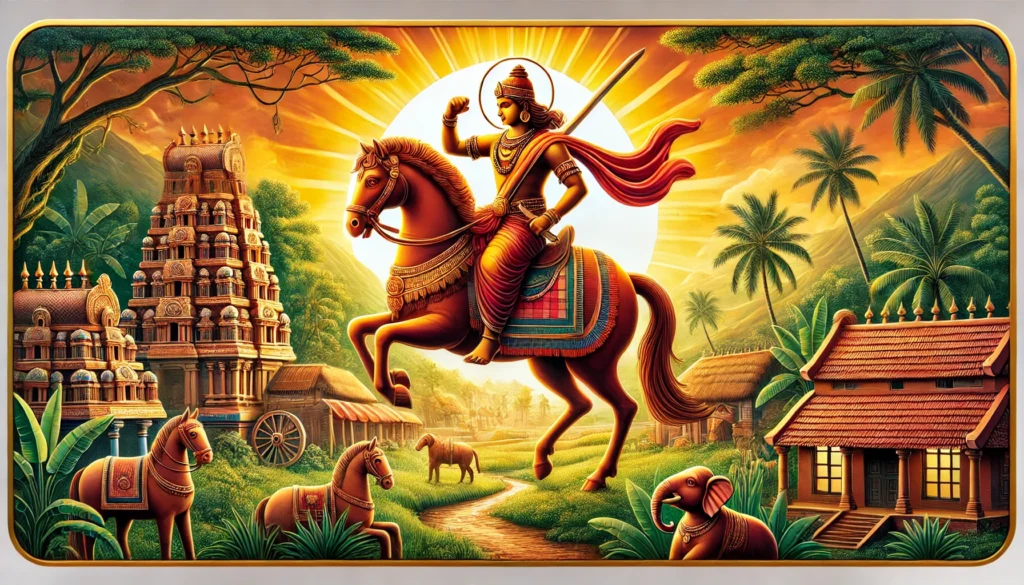Discover the legacy of Ayyanar, the guardian deity of Tamil Nadu villages. Learn about his mythology, rituals, terracotta art, and cultural significance in preserving rural traditions and unity.
In the rural heartlands of Tamil Nadu, Ayyanar, the guardian deity, stands as an indomitable symbol of protection and prosperity. His larger-than-life terracotta horses, vibrant shrines at village boundaries, and a legacy steeped in mythology make him one of the most beloved deities among Tamil villagers. Ayyanar’s worship reflects a unique blend of spirituality, community values, and artistic heritage.

Growing up, I spent summers in my grandmother’s village near Madurai. One of the highlights of these visits was the annual Ayyanar festival, where the entire village came alive with music, rituals, and storytelling. Even as a child, the sight of Ayyanar’s towering terracotta horses filled me with awe. My grandmother would narrate tales of how he protected the village from evil spirits, and those stories became a lens through which I understood the community’s shared sense of security and faith.
Let’s explore Ayyanar’s origins, rituals, and significance, weaving in these personal experiences to uncover why this deity remains an integral part of Tamil Nadu’s cultural and spiritual landscape.
The Origins of Ayyanar: Protector of Villages
Ayyanar’s worship predates classical Hinduism, rooted in ancient Dravidian traditions that emphasized the protection of nature and community. While some consider him an incarnation of Lord Shiva or a brother of Murugan, many see Ayyanar as a purely folk deity, embodying local beliefs and customs.
Mythological Tales of Ayyanar
One of the most popular legends about Ayyanar involves his divine birth. According to folklore, Ayyanar is the son of Lord Shiva and Mohana, a celestial nymph. Endowed with immense strength and a warrior spirit, Ayyanar was tasked with protecting villages from evil forces, ensuring harmony and prosperity.
Another tale speaks of his companionship with Karuppu Sami, another fierce guardian spirit. Together, they patrol the village boundaries, warding off malevolent entities. This partnership reinforces the idea of collective guardianship, a theme central to Tamil rural traditions.
Ayyanar’s Unique Iconography
One of the most striking aspects of Ayyanar worship is his iconography, which vividly reflects his role as a protector.
- Terracotta Horses
Ayyanar is often depicted riding a horse, symbolizing his readiness to safeguard the village. The terracotta horses offered by devotees are iconic; they represent fulfilled prayers or gratitude for his protection. Each horse is handcrafted by local artisans, and their intricate details speak volumes about Tamil Nadu’s rich artistic heritage. - Rustic Shrines
Ayyanar shrines are unique in that they are often located on the outskirts of villages, marking the boundary between the human settlement and the wilderness. These open-air shrines blend seamlessly with the natural environment. - Weaponry and Attire
Ayyanar is usually depicted holding a sword or staff, symbolizing his authority and readiness to dispense justice. His imposing figure, often accompanied by other guardian deities, exudes strength and vigilance.
Learn more about terracotta art in India here.
Worship of Ayyanar: A Rural Devotion
The worship of Ayyanar is deeply ingrained in Tamil Nadu’s rural culture. His devotees rely on him not only for protection but also for guidance in agricultural prosperity and community welfare.
Rituals and Offerings
- Terracotta Offerings
Devotees create or commission terracotta horses, elephants, and other figurines as offerings to Ayyanar. These offerings are symbolic of their gratitude for blessings received or prayers answered. - Annual Festivals
Ayyanar festivals are grand affairs, marked by processions, music, and dance. In my grandmother’s village, the festival lasted for three days, with villagers participating in rituals and storytelling sessions that brought Ayyanar’s myths to life. - Guardianship Rites
During specific times of the year, villagers perform special pujas to invoke Ayyanar’s protection against natural calamities or evil spirits. These rituals are a reminder of his constant watch over the community.
Ayyanar’s Cultural Significance
Ayyanar’s worship is more than a religious practice; it is a cultural phenomenon that fosters community unity and preserves Tamil Nadu’s artistic and spiritual heritage.
Ayyanar as a Symbol of Unity
In Tamil villages, Ayyanar is revered by people from all walks of life, transcending caste and class barriers. His shrines serve as gathering spaces where villagers come together to celebrate festivals, resolve disputes, and share stories. This collective worship strengthens community bonds and reinforces a shared sense of identity.
Preserving Artistic Traditions
The terracotta sculptures associated with Ayyanar worship are a testament to Tamil Nadu’s rich artisanal traditions. Artisans, often working in rural settings, pass down their skills through generations, ensuring that this unique craft continues to thrive.
Personal Reflections: A Childhood Memory
One vivid memory I have of Ayyanar worship is a visit to his shrine during a monsoon season. The river near our village had risen dangerously, threatening to flood the fields. The village elders organized a special puja for Ayyanar, offering terracotta horses and lighting oil lamps. I watched in awe as they chanted prayers, their faith palpable. The next day, the rains subsided, and the river calmed—a moment many attributed to Ayyanar’s divine intervention.
That experience instilled in me a deep respect for the collective faith of the community and the role of Ayyanar as a protector, not just of the village but of its spirit.
Lessons from Ayyanar Worship
Ayyanar’s worship offers timeless lessons that remain relevant in today’s world:
- Community Over Individualism
Ayyanar reminds us of the power of unity and the importance of prioritizing the well-being of the collective over individual interests. - Harmony with Nature
The placement of his shrines at village boundaries signifies a respect for the natural world and the need to maintain balance. - Gratitude and Fulfillment
The tradition of offering terracotta horses teaches us to express gratitude and honor our commitments. - Cultural Preservation
In a rapidly modernizing world, Ayyanar’s worship highlights the importance of preserving cultural and spiritual heritage.
Ayyanar in Modern Context
As urbanization encroaches upon rural landscapes, the worship of Ayyanar faces challenges. However, efforts are being made to document and preserve these traditions, ensuring that future generations can continue to connect with this rich heritage.
For ongoing initiatives to preserve folk traditions, visit Cultural Preservation Organization.
A Timeless Protector
Ayyanar, the guardian deity of Tamil Nadu villages, is more than just a figure of worship. He represents the enduring values of protection, unity, and cultural pride. His vibrant shrines, terracotta offerings, and compelling myths continue to inspire faith and devotion, even in the face of change.
Whether you are a devotee or a curious traveler, visiting an Ayyanar shrine is a journey into the heart of Tamil Nadu’s rural heritage. It is an experience that will leave you with a deeper appreciation of the community, nature, and the enduring power of faith.
Author:
Aditya Chauhan – Temple Architect & Historian
Email: aditya@hindutva.online

